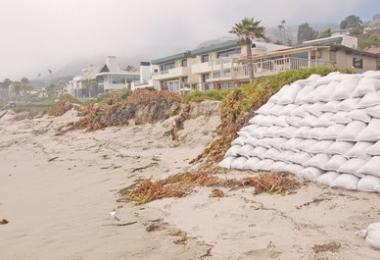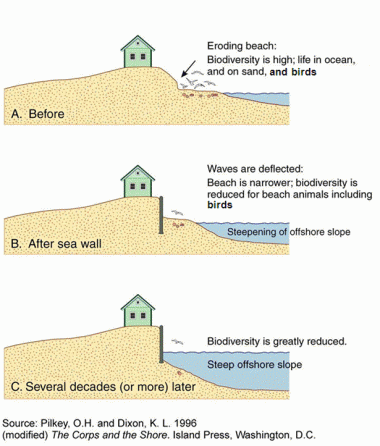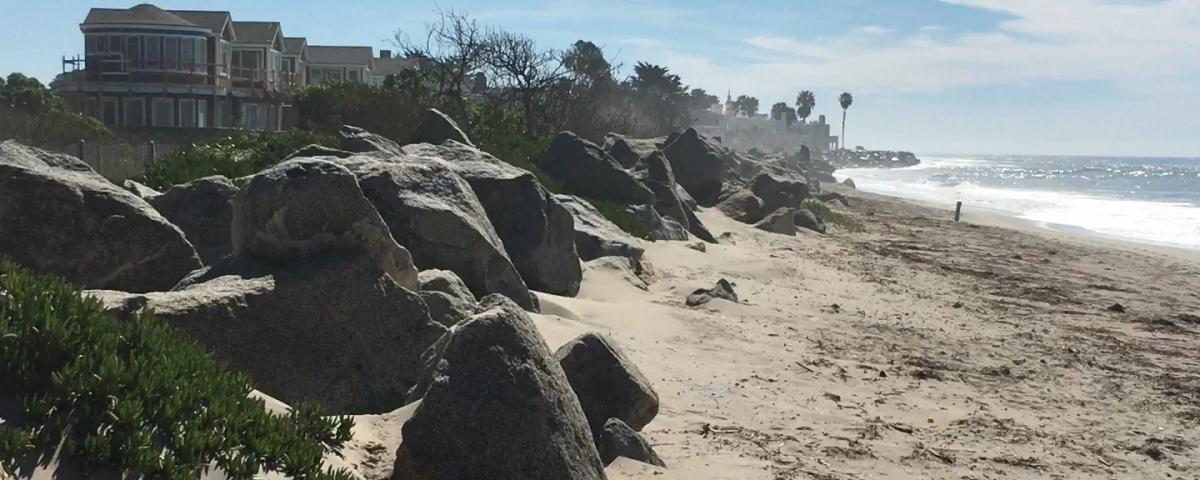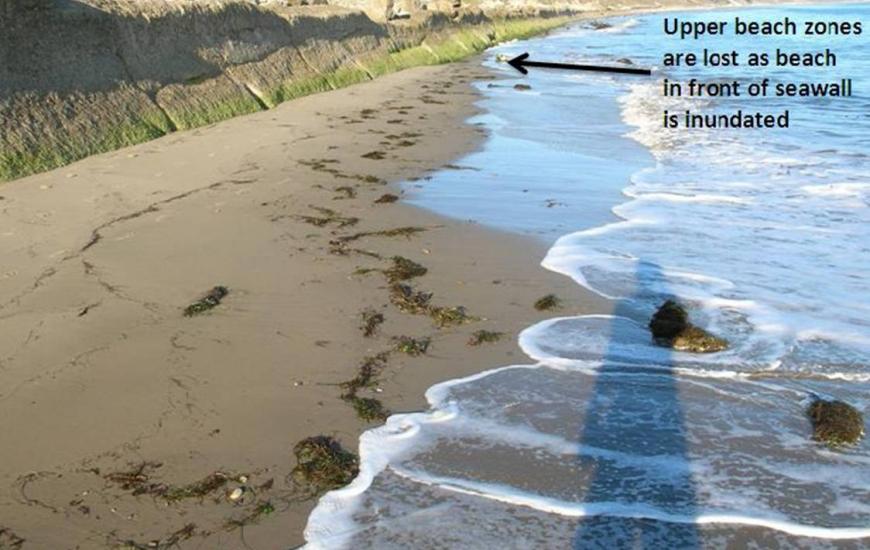
What is Coastal Armoring?
On the Southern California coast homes, other buildings, and infrastructure often are located very close to the shore. The shoreline is armored, or reinforced to protect development by preventing shoreline retreat.
Armoring comes in many forms, from relatively temporary sandbags (below, left), to seawalls (middle), to offshore breakwaters (below, right) that block wave energy at harbors. The call for armoring of the coastline is likely to increase as the effects of sea level rise due to climate change are felt.
Impacts of Coastal Armoring
Although an armored section of shoreline may be protected from further retreat due to erosion, armoring structures can actually increase erosion on the beach itself and on surrounding beaches. This occurs because armoring modifies the pattern of sand movement along the coastline. In general, the closer the armoring structure is to the water, the greater the impact on the beach.

Because armoring structures fix the shoreline, beaches cannot migrate inland like they normally would when waves, storms, or sea level rise erode the coastline. With nowhere to go, the drier upper zones of the beach disappear, and the “bands” of different beach habitats are squeezed between the ocean and seawalls.
Depending on the placement of the armoring structure and the ocean conditions, impacts can include:
Ecological Impacts
- Habitat destruction from the placement of the structure itself
- Passive erosion of the beach directly in front of the structure
- Disproportionate loss of habitats on the upper beach, including the upper intertidal and coastal strand zones
- Reduction of the width of the middle intertidal zones
- Reduction in biodiversity and abundance of sand-dwelling animals.
- Loss of upper beach nesting habitat needed by California grunion
- Loss of marine mammal haul-out area.
- Severe impacts to beach plants and sand-dwelling animals immediately in front of seawalls
- Decreased deposition and retention of wrack, a key component of the beach food web, with strong impacts on biodiversity, nutrient cycling and wildlife support.
- Reduction in beach use by shorebirds, seabirds and land birds in front of armoring structures due to habitat loss and the reduction in prey. Remarkably, these impacts extend to roosting, as well as foraging birds.
- Loss of room for habitats to migrate inland as the sea level rises.
- Possible benefit to invasive species, since artificial structures, like seawalls and jetties can serve as habitat for them.
Economic and Recreational Impacts
- Economic cost, including the initial investment in the construction of the armoring features themselves and maintenance costs.
- Decreased tourism and tourism revenue to local communities due to a reduction in beach width.
- Less connectivity between beaches (which is often called lateral access) restricts recreational use of the beach

In addition, as sea level rises, armoring that may be presently above the reach of waves and tides will become exposed to wave processes.
Beachapedia explains some terminology for the various impacts of seawalls on beaches.
Explore the interactive map to find an armored or pristine beach near you
When is Armoring Allowed?
The California Coastal Commission is the state agency that regulates development on California’s coast along the open ocean. All armoring projects require permits from either the California Coastal Commission or the jurisdiction in which the project is taking place.
Shoreline armoring can protect development along the shoreline but can be harmful to many coastal resources. A central goal of the Coastal Commission is to protect coastal resources and ensure that coastal development has minimal impacts on those resources.
In general the construction of seawalls is minimized. However, the Coastal Commission allows them to be constructed if used to protect either existing development or development that must, by definition, be sited on the coast (e.g. a port).
Recognizing the negative effects of seawalls, the Commission has recently been adding a “no future seawall” provision to many permits for coastal development, which requires the property owner to waive future rights to any future shoreline protection.
More information and images of coastal armoring are available from the Monterey Bay National Marine Sanctuary. Read more about the benefits and drawbacks of coastal armoring at NOAA and Beachapedia.
Quick Facts
- Erosion can eat away at the shoreline and threaten coastal roads, buildings, and homes. Reduced sand supply to the coast can exacerbate this process.
- To protect coastal development, the shoreline is often reinforced with armoring. This may be anything from a temporary installation, like sandbags, to a more permanent form, such as a seawall or revetment.
- Although armoring can protect property on land by fixing the position of the shoreline, it can have many adverse ecological and recreational consequences. Ironically, armoring can reduce beach width and increase the rate of coastal erosion nearby, resulting in loss of valuable public beaches, ecosystem functions, biodiversity, and lateral access.



